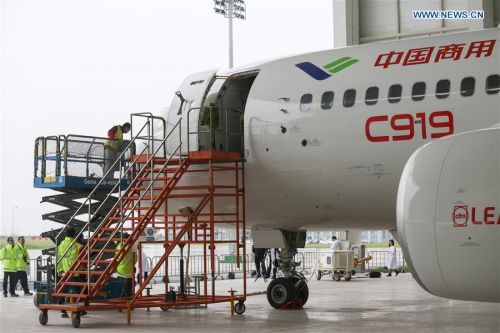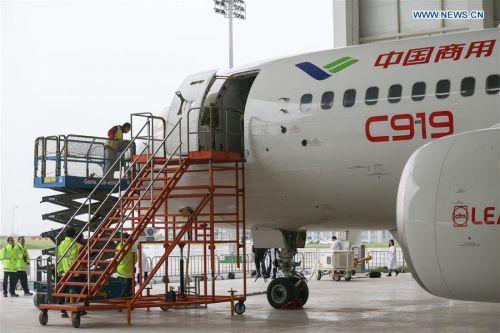
Staff workers check a C919, China's first domestically-built large passenger jet, at a hangar of the Commercial Aircraft Corporation of China (COMAC) in Shanghai, east China, May 4, 2017. The maiden flight of the C919 is scheduled for May 5. The flight will depart from Shanghai Pudong International Airport. "If weather conditions are not suitable, the maiden flight will be rescheduled," COMAC said. (Xinhua/Ding Ting)
BEIJING, May 4 (Xinhua) -- While the much-awaited first Chinese-built passenger jet C919 is ready to make its maiden flight Friday, it may take much longer for the newcomer to take off in the aviation market.
Shaking the dominance of aviation giants Boeing and Airbus in the near future is unrealistic, observers say, but the Chinese jetliner could be a strong option for global carriers in decades to come.
Scheduled to depart from Shanghai Pudong International Airport on May 5, the C919, with 158 seats and a standard range of 4,075 kilometers, is expected to compete with the updated Airbus 320 and Boeing's new generation 737.
A total of 23 foreign and domestic customers, including China's national carrier Air China and leasing company GE Capital Aviation Service, have placed orders for 570 aircraft, according to the Commercial Aircraft Corporation of China (COMAC).
But this is only the very first step. Even in China's domestic market, COMAC has a long way to go to turn technical success into business success.
Currently, Chinese airlines seem to be more keen to spend money on wide-body aircraft to enhance their global routes with rising enthusiasm for overseas travel. Those jets are still the exclusive province of Boeing and Airbus.
China Eastern Airlines signed contracts in 2016 to buy 20 A350-900 aircraft from Airbus and 15 B787-9 aircraft from Boeing to be delivered between 2018 and 2022.
China Southern Airlines announced in April that it will buy 20 A350-900 with a total catalog price of nearly 6 billion U.S. dollars.
Boeing and Airbus are very mature aircraft manufacturers, and COMAC should seek further cooperation with them to learn from their experiences, according to aviation analysts.
But looking ahead, single-aisle planes like C919 will be the market mainstream and COMAC should do well in the Chinese market, one of the most competitive.
Boeing predicted last year that China will become the world's top aviation market within 20 years, projecting a demand for 6,810 new aircraft in the next two decades with a total value of 1 trillion U.S. dollars.
China will need 5,110 new single-aisle airplanes through 2035, accounting for 75 percent of the total new deliveries, according to Boeing.
The C919 will be a strong competitor in this field being economical and comfortable, according to a research note from Guosen Securities.
If the maiden flight is successful, COMAC will seek airworthiness certificates from the Civil Aviation Administration of China and foreign aviation safety regulators before making its first deliveries.
Also, to pave way for C919 to enter foreign markets, the airworthiness certification of the jet will be a part of bilateral air safety agreement talks between China and the EU.
China has invested heavily in commercial passenger jet manufacturing. In 2007, plans to develop a domestic large passenger jet were approved by the State Council. In November 2015, the first C919 jet rolled off the assembly line.
The ARJ21, the country's first regional aircraft also produced by COMAC, began commercial operations in June 2016 following its maiden flight in 2008.




 A single purchase
A single purchase









